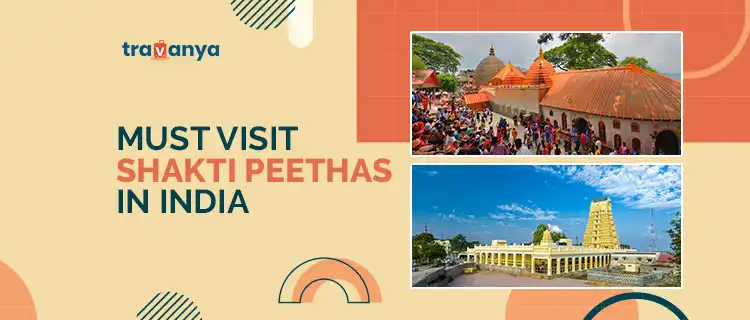
List of the Most Mysterious & Powerful Shakti Peethas – A Spiritual Journey
Posted on Thursday, October 24th, 2024 by Navneet Kaur Leave a Comment
India is a country rich in cultural diversity and deep religious feelings. The temples here are famous around the world for their pretty beauty & grandeur. People from various religions, not just Hindus, hold these temples in high regard. Many renowned temples & Shakti Peeths in India are significant pilgrimage sites for Hindus.
Shakti Peeths, which means “seat of power,” are special worship places dedicated to Goddess Shakti, the main female deity in Hinduism. Different Puranas mention that there are 51, 52, 64, or even 108 Shakti Peeths. Each Shakti Peeth is associated with a unique aspect of the goddess Shakti, who represents divine feminine power in Hindu beliefs.
Table Of Content
| 4 Powerful Shakti Temples In India- Adi Shakti Peethas | |
| 1. Bimala Temple | Pada Khanda |
| 2. Maa Taratarini Temple | Sthana Khanda |
| 3. Kamakhya Temple | Yoni Khanda |
| 4. Kalighat Kali Temple | Mukha Khanda |
| List of Shakti Peethas -Aastadasa Shakti Peethas | |
| 1. Sri Kanchi Kamakshi Amman Temple | Kama Koti Peetham |
| 2. Shrinkala Devi Temple | Bhavatārini Peetham |
| 3. Sri Chamundeshwari Temple | Krouncha Peetham |
| 4. Alampur Jogulamba Temple | Yogini Peetham |
| 5. Bhramaramba Mallikarjuna Temple | Srisaila Peetham |
| 6. Mahalakshmi Temple | Shri Peetham |
| 7. Eka Veerika Temple | Moola Peetham |
| 8. Shakambhari | Shakambhari Peetham |
| 9. Sri Kukkuteswara Swamy Temple | Pushkarini Peetham |
| 10. Biraja Temple | Oddyana Peetham |
| 11. Draksharama Bheemeswara Swamy Temple | Daksharama Peetham |
| 12. Alopi Devi Mandir | Prayaga Peetham |
| 13. Jwalamukhi Temple | Jwalamukhi Peetham |
| 14. Mangla Gauri Temple | Gaya Peetham |
| 15. Vishalakshi Temple | Varanasi Peetham |
| List of Others Shakti Peethas |
4 Powerful Shakti Temples In India – Adi Shakti Peethas
1. Bimala Temple – Pada Khanda
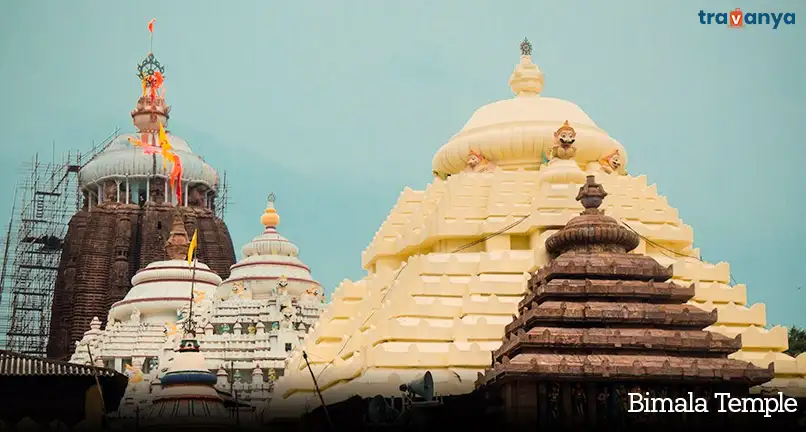
Bimala Temple, also known as Vimala Mandir, is a significant religious site in Puri, Odisha, India. It is dedicated to Goddess Bimala, who is an incarnation of Parvati. The temple complex includes the main shrine & several smaller shrines located within the Jagannath Temple. It is considered one of the holiest Hindu temples, drawing millions of pilgrims each year.
Bimala Temple is one of the 51 Shakti Peeths in India. It is an important place for Hindu pilgrims, who believe that the feet (Pada) of Goddess Sati, the wife of Shiva, fell at this location. The temple is mentioned in ancient texts like the Puranas & the Skanda Purana. Every year, many visitors come to pray and appreciate the beauty of this beautiful example of Kalinga architecture.
- Location: Sri Jagannatha Temple, Puri – RR39+R2M, Puri, Odisha 752001
- Country: India
- Nearest Airport: Biju Patnaik International Airport (BBI)
- Built In: 9th Century
- Built By: Yayati Keshari (Somvanshi Dynasty)
- Deity: Vimala (Bimala)
- Architectural Style: Kalinga Architecture
- Temple Timings: 6:00 AM to 11:30 AM, 3:00 PM to 9:00 PM
- Festivals: Durga Puja
- Best Time to Visit: March to July
Maa Taratarini Temple – Sthana Khanda
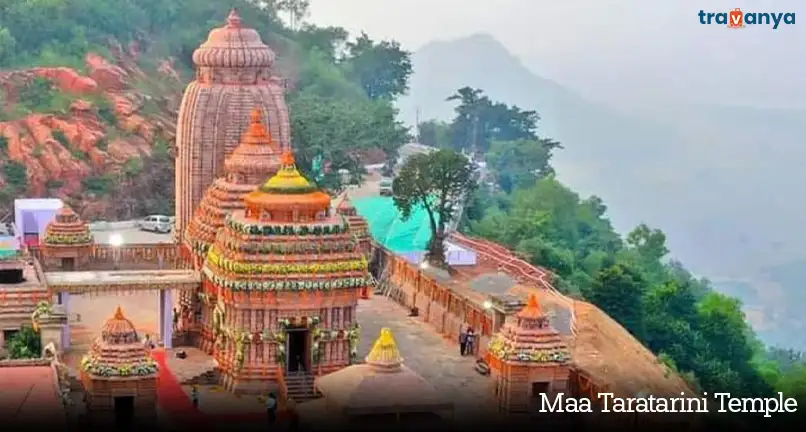
Tara Tarini Temple is one of the most significant & well-known temples in Odisha. Located on the banks of the Rushikulya River in the Ganjam district, this temple is dedicated to Lord Shiva & Goddess Parvati. The main deity of the temple is Tara Tarini, an incarnation of Parvati, represented by two stone sculptures adorned with gold & silver ornaments.
According to legend, this is one of the oldest temples in India. It is also recognized as an important Shakti Peeth, often referred to as Tantra Peeth. It is believed that the breasts of Goddess Sati fell at this site. Mata Tara Tarini is regarded as the supreme mother goddess, & devotees believe that she grants blessings & salvation to her worshippers.
- Location: Temple Road, near Rushikulya River, Raipur, Purusottampur, Odisha 761018
- Country: India
- Nearest Airport: Biju Patnaik International Airport (BBI)
- Built In: Satya Yuga
- Built By: Kalinga Emperors in Ancient Period and Basupraharaj in the 17th Century during the Medieval Period
- Deity: Tara and Tarini (Tara & Adi Mata/Adi Shakti)
- Architectural Style: Kalinga Architecture
- Temple Timings: 6:30 AM to 12:30 PM, 2:00 PM to 5:30 PM, 6:30 PM to 8:30 PM
- Festivals: Chaitra Mela/Chaitra Parva/Chaitra Yatra, Dussehra, Navaratri, Diwali, Sankranti
- Best Time to Visit: March to April
3. Kamakhya Temple – Yoni Khanda
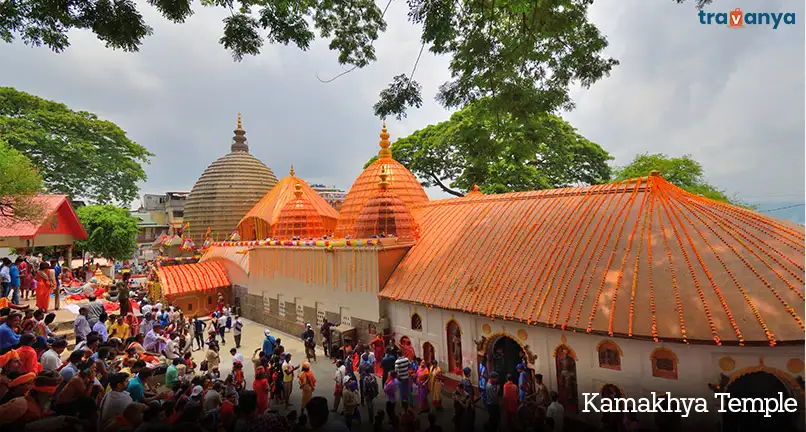
Kamakhya Temple is one of the most significant temples in India, dedicated to Goddess Kamakhya. Located in Guwahati, Assam, it is one of the 18 Shakti Peeths, which are pilgrimage sites for devotees of the Hindu goddess Shakti. In this temple, Kamakhya Devi is often referred to as the bleeding Goddess, & it features a unique yoni section that symbolizes the female genitalia.
According to legend, the Yoni Khand is the spot where the womb of Sati, the wife of Lord Shiva, fell when her body was cut into pieces by Vishnu. The temple is mentioned in ancient Puranas & is considered one of the oldest temples in India. Today, Kamakhya Temple holds immense importance in Indian spirituality, & visiting it is regarded as highly auspicious. Travelers can explore this Shakti Peetha by booking a North-East Tour Package that includes this temple in their itinerary.
- Location: Kamakhya, Guwahati, Assam 781010
- Country: India
- Nearest Airport: Lokpriya Gopinath Bordoloi International Airport (GAU)
- Built In: 8th-17th Century
- Built By: Mlechchha dynasty, later rebuilt by Koch King Nara Narayan and Ahom kings
- Deity: Kamakhya
- Architectural Style: Nilachal Architecture
- Temple Timings: 5:30 AM to 1:00 PM, 2:30 PM to 5:30 PM
- Festivals: Ambubachi Mela
- Best Time to Visit: June
4. Kalighat Kali Temple – Mukha Khanda
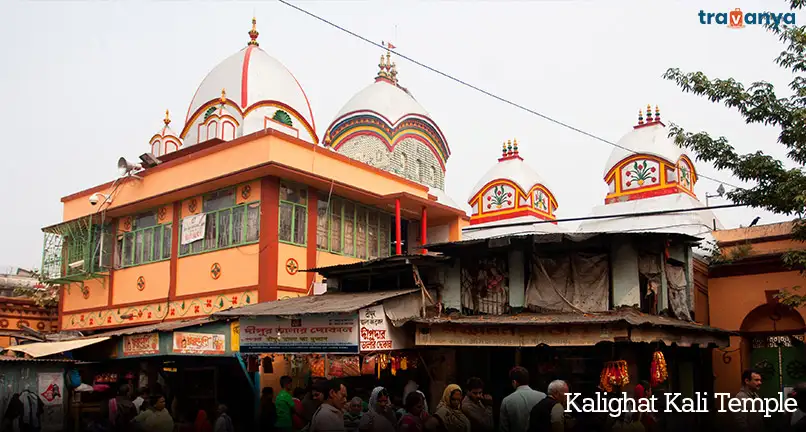
Kalighat Temple, situated in Kolkata, West Bengal, is one of the most renowned temples in India. This sacred site is dedicated to Goddess Kali & is located in the crowded heart of Kolkata. It is also referred to as Mukha Khanda, which means “face of Dakshayani.” Kalighat is recognized as one of the 51 Shakti Peethas in India.
According to Hindu mythology, Kalighat is one of the oldest & most revered temples, believed to be the place where the face of Dakshinayani (Goddess Sati) fell. The temple is mentioned in ancient texts & is as old as the Vedas. Today, Dakshina Kali draws many local visitors & attracts thousands of pilgrims each year, making it a significant spiritual destination.
- Location: Anami Sangha, Kalighat, Kolkata, West Bengal 700026
- Country: India
- Nearest Airport: Netaji Subhas Chandra Bose International Airport
- Built-In: 1809
- Built-By: Sabarna Roy Choudhury
- Deity: Kali
- Architectural Styles: Bengal Architecture
- Temple Timings: 5.00 AM to 2.00 PM, 5.00 PM to 10.30 PM
- Festivals: Kali Puja
- Best Time To Visit: October to November
List of Shakti Peethas – Aastadasa Shakti Peethas
1. Sri Kanchi Kamakshi Amman Temple – Kama Koti Peetham
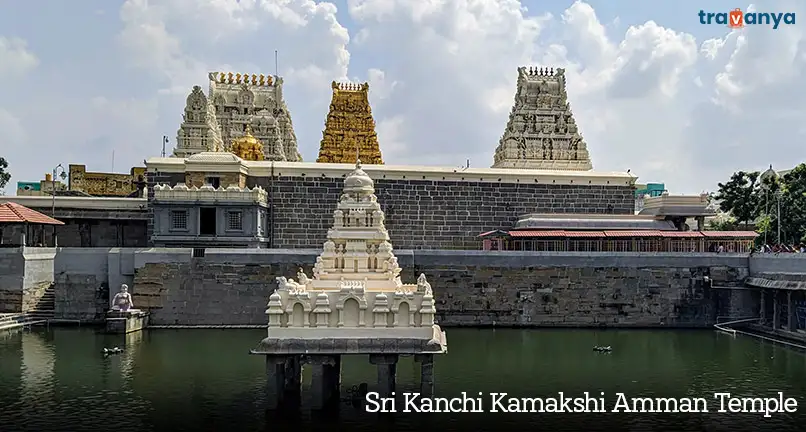
Kamakshi Amman Temple is located in Kancheepuram, Tamil Nadu, India. This temple is dedicated to Goddess Kamakshi, who is also known as the supreme Goddess Lalita Maha Tripura Sundari & is worshipped as the consort of Shiva. Along with the Meenakshi Temple in Madurai & the Akilandeswari Temple in Thiruvanaikaval, the Kamakshi Temple is an important place of worship for goddesses.
According to legend, the back of Goddess Sati’s body fell at this site, making Kamakshi Amman Temple one of the Maha Shakti Peethas, or places of great spiritual power, in India. As one of the holiest & wealthiest temples in the country, it attracts millions of Hindu pilgrims every year who come to seek blessings & admire its beauty.
- Location: Kamakshi Amman Sannathi St, Kanchipuram, Tamil Nadu 631502
- Country: India
- Nearest Airport: Chennai International Airport (MAA)
- Built-In: 5th BCE to 8th CE.
- Built-By: Pallava Kings
- Deity: Kamakshi
- Architectural Styles: Dravidian Architecture
- Temple Timings: 5:30 AM to 12:00 PM, 4:00 PM to 8:00 PM
- Festivals: Chariot Festival, Theppam, Navaratri, Aadi and Aippasi Pooram, Sankara Jayanthi and Vasanta Utsavam
- Best Time To Visit In: Mid-February to Mid-March
2. Shrinkala Devi Temple – Bhavatārini Peetham
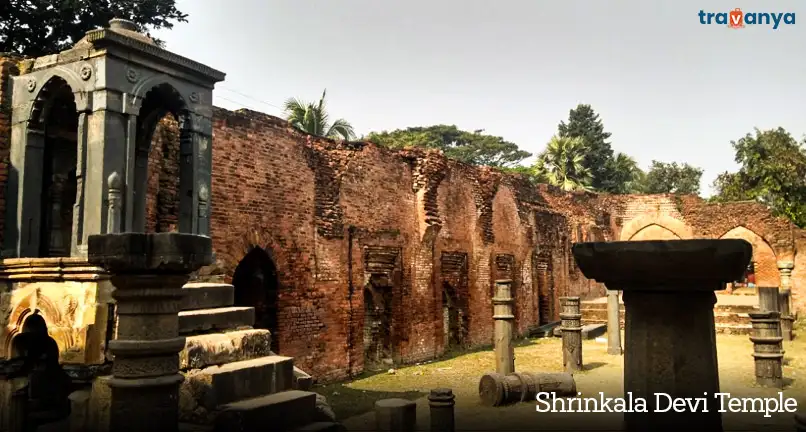
Shrinkala Devi Temple is a Hindu temple located in Pandua Town, Hooghly District, West Bengal, India. It is dedicated to Goddess Sati & is recognized as one of the Shakti Peethas in the Indian subcontinent. According to legend, the great sage Rishyasringa Maharshi worshipped Shrinkhala Mata for many years & received her blessings.
It is also believed that after self-immolation, part of Goddess Sati’s stomach fell to the ground at this site, making it a powerful Shakti Peeth, or place of spiritual energy, in India. Unfortunately, the temple was destroyed by Muslim invaders, who built a tall tower in its place. Today, the temple ruins can be found near the minaret, & the site is managed by the Archaeological Survey of India.
- Location: SH 13, Pandua, Hooghly West Bengal 712149
- Country: India
- Nearest Airport: Netaji Subhas Chandra Bose International Airport (CCU)
Important Note: There is considerable debate about the exact location of the Shrinkhala Mata Temple. Some people believe it is situated in Ganga Sagar, West Bengal, while others argue it is in Sringeri, Karnataka. Additionally, some claim that it can be found in Chotila, Gujarat. However, the majority agree that Shrinkala Devi is primarily worshipped at Pandua, located near the Hooghly district in West Bengal.
3. Sri Chamundeshwari Temple – Krouncha Peetham
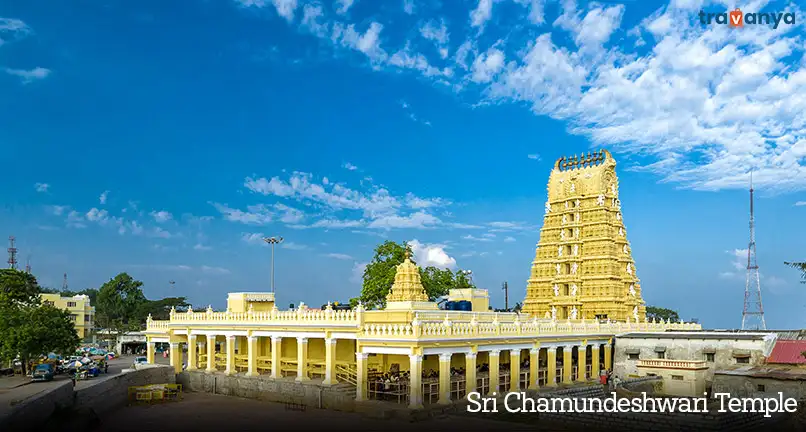
Sri Chamundeshwari Temple, located in the city of Mysore, Karnataka, India, is a renowned temple dedicated to the Hindu Goddess Maa Shakti. Nestled atop the Chamundi Hills, this temple is deeply connected to the history & culture of the region, particularly with the ruling Hoysala dynasty & the Vijayanagara Empire, which governed Mysore for many centuries.
Recognized as one of the eighteen Shakti Peethas, Chamundeshwari Temple is a highly revered destination for Hindus throughout India. According to legend, the hair of Goddess Sati, Shiva’s wife, fell to the earth at this site after her self-immolation. The temple’s architecture & intricate carvings are remarkable, making it one of the most elaborately designed temples in India.
- Location: Chamundeshwari Temple, Chamundi Hill, Mysuru, Karnataka 570010
- Country: India
- Nearest Airport: Kempegowda International Airport (BLR)
- Built-In: 12th Century
- Built-By: Hoysala Dynasty
- Deity: Chamundeshwari
- Architectural Styles: Dravidian Architecture
- Temple Timings: 7:30 AM to 2:00 PM, 3:30 PM to 6:00 PM, 7:30 PM to 9:00 PM
- Festivals: Navaratri, Ashada Shukravara, and Ammanavara Vardhanthi
- Best Time To Visit In: June to July
4. Alampur Jogulamba Temple – Yogini Peetham
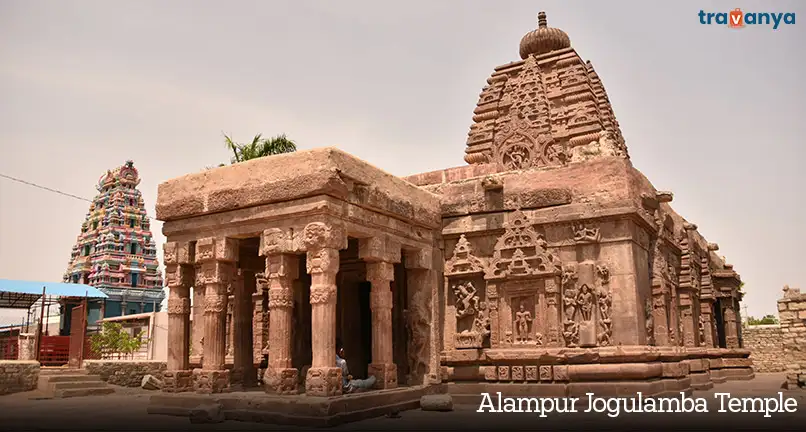
Alampur Jogulamba Temple is one of the Maha Shakti Peethas, a collection of eighteen (Ashtadasa) temples situated in the Jogulamba Gadwal district of Telangana, India. This temple is dedicated to Goddess Jogulamba, an incarnation of Shakti. According to legend, the upper teeth of Goddess Sati fell at this location while Shiva was carrying her body after her self-immolation.
The temple is part of a complex that includes nine Shiva temples constructed in the 17th & 18th centuries CE. The temples are intricately carved & adorned with numerous sculptures & paintings on their walls. This ancient temple holds great religious significance for Hindus in Telangana & attracts thousands of pilgrims each year.
- Location: Temple Road, Alampur, Gadwal, Telangana 509152
- Country: India
- Nearest Airport: Rajiv Gandhi International Airport (HYD)
- Built-In: 7th to 8th century CE
- Built-By: Badami Chalukyas Rulers
- Deity: Devi
- Architectural Styles: Dravidian Architecture
- Temple Timings: 7:00 AM to 1:00 PM, 2:00 PM to 8:30 PM
- Festivals: Maha Shivratri, Navaratri, Purnima, Makar Sankranti
- Best Time To Visit In: July to September
5. Bhramaramba Mallikarjuna Temple – Srisaila Peetham
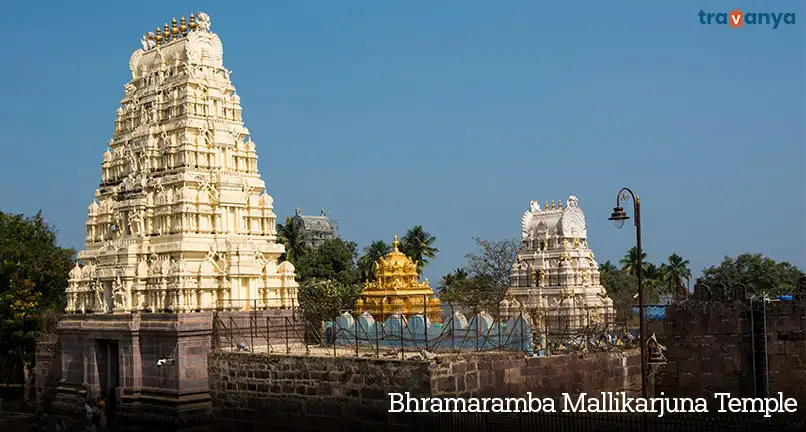
Mallikarjuna Temple, located in Srisailam, is dedicated to Lord Shiva and is one of the 12 Jyotirlingas in India. Nestled in the Nallamala hills, the temple complex also includes the Bhramaramba Devi Temple, dedicated to the Hindu Goddess Bhramarambika. She is regarded as the wife of Lord Mallikarjuna Swamy, an incarnation of Lord Shiva.
In this temple, the Goddess is worshipped as Brahmani Shakti, representing the power of divine knowledge. Srisailam is notable for housing one of the 18 Shakti Peethas in India, making it a significant pilgrimage site for devoted worshippers. According to legend, a part of Goddess Sati’s neck is believed to have fallen here, leading to the area’s recognition as a sacred destination for devotees of the Goddess from all over the country.
- Location: Srisailam, Andhra Pradesh 528101
- Country: India
- Nearest Airport: Rajiv Gandhi International Airport (HYD) & Vijayawada International Airport (VGA)
- Built-In: 2nd Century
- Built-By: Satavahana dynasty
- Deity: Ekavenika Devi
- Architectural Styles: Dravidian Architecture
- Temple Timings: 5:30 AM to 9:30 PM
- Festivals: Maha Shivratri, Navaratri
- Best Time To Visit In: February or October
6. Mahalakshmi Temple – Shri Peetham
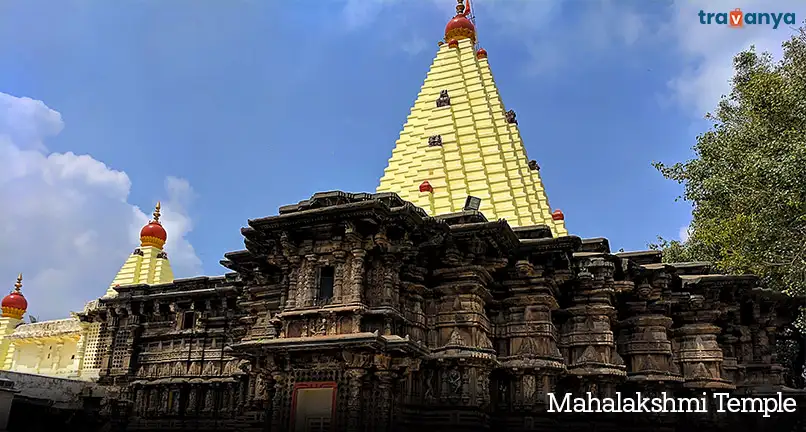
Mahalaxmi Temple, also known as Ambabai Temple, is situated in Kolhapur, Maharashtra, India. It is a significant pilgrimage site in Hinduism & is dedicated to Mahalakshmi, the consort of Lord Vishnu, who embodies wealth, prosperity, & good fortune. This temple is one of the three & a half Shakti Peethas mentioned in various Puranas (ancient Hindu texts) & is often referred to as Dakshin Kashi.
According to legend, a part of Goddess Sati’s eye is believed to have fallen at this location, making it a revered site dedicated to the feminine aspect of the Goddess. The Kolhapur Peeth holds great religious significance for Hindus, as it is considered one of the six sacred places where devotees can achieve liberation from desires or fulfill them.
- Location: Mahadwar Road, B Ward, C Ward, Kolhapur, Maharashtra 416012
- Country: India
- Nearest Airport: Kolhapur Airport (KLH), Pune International Airport (PNQ)
- Built-In: 7th century CE
- Built-By: Chalukya Empire
- Deity: Aai Ambabai
- Architectural Styles: Hemadpanti architecture
- Temple Timings: 7:00 AM to 10:00 PM
- Festivals: Kirnotsav, Rathotsav, Lakshmi Puja, Lalita Panchami, Navratri, Diwali, Varalakshmi Vratham
- Best Time To Visit In: September to October
7. Eka Veerika Temple – Moola Peetham
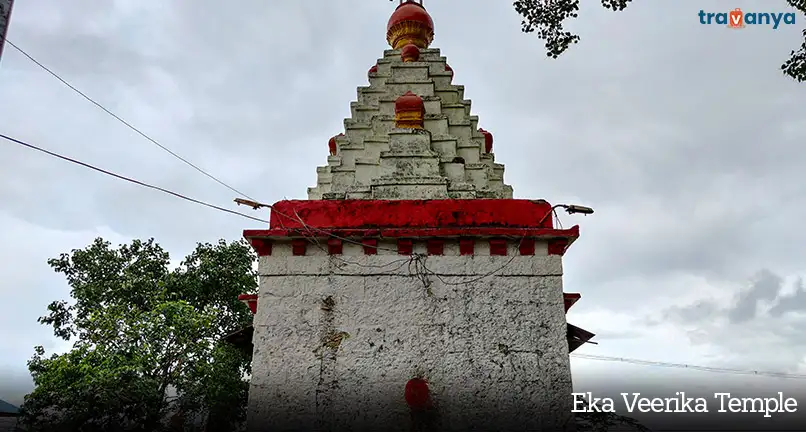
Renuka Devi Temple, also known as EkaVeerika Temple, is located in Maharashtra, India. This temple is dedicated to Goddess Renuka Devi, who is also referred to as Ekavirika Devi, Renukamba, and Yellamma. In Hindu mythology, she is the wife of sage Jamadagni & the mother of Parashurama, an incarnation of Lord Vishnu.
According to the Shlokas of Shri Adi Shankaracharya’s Shakti Peethas, this temple is recognized as one of the 18 Shakti Peethas in India, often referred to as ‘Mahurye Ekaveerika’. Legend has it that the left hand of Goddess Sati fell at this site. As one of the Aastadasa Shakti Peethas, the Renuka Devi Temple holds special spiritual significance. Every year, thousands of pilgrims visit to offer their prayers and seek blessings.
- Location: RWXF+G4C Bhopi Near Tea Point, Patil Colony, Mahurgad, Maharashtra 431721
- Country: India
- Nearest Airport: Nanded Airport (NDC), Dr. Babasaheb Ambedkar International Airport (NAG)
- Built-In: 1000 Years Ago
- Funded-By: Rishi Jamdagni
- Deity: Ekaveerika Devi
- Temple Timings: 24 Hours
- Festivals: Navratri
- Best Time To Visit In: Any Time
8. Shakambhari – Shakambhari Peetham
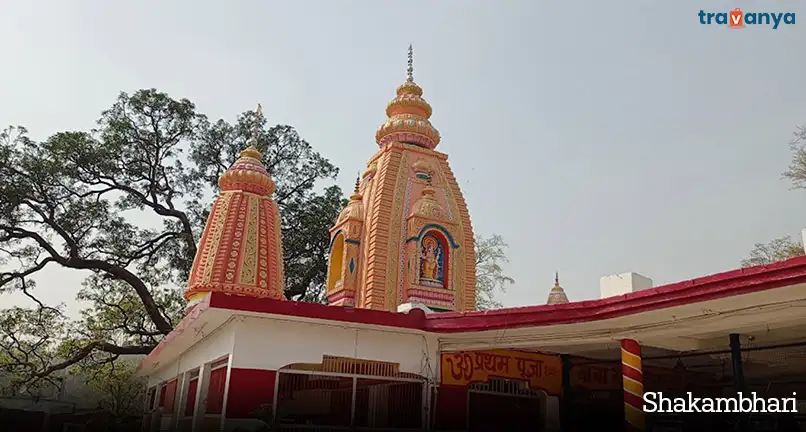
Siddha Peeth Shri Shakumbhari Devi is a renowned & powerful temple situated in the Saharanpur district of India. This sacred site is dedicated to the Hindu goddess Shakumbhari Devi, known for nourishing humanity with fruits & vegetables. Believed to have been established by the Marathas, the temple is steeped in history.
As a Maha Shakti Peeth, Siddha Peeth Shri Shakumbhari Devi is regarded as a site of immense spiritual power. According to legend, the head of Goddess Sati fell here, adding to the temple’s significance for devotees of Shiva & Shakti. Nestled in the Shivalik mountain range, it is a popular destination for worshippers seeking blessings & guidance from the divine.
- Location: 7P4R+MX5, Jasmer, Uttar Pradesh 247121
- Country: India
- Nearest Airport: Jolly Grant International Airport – Dehradun (DED)
- Built-In: 1000 – 2000 Years Ago
- Built-by: Marathas (only a believed)
- Deity: Shakumbari Devi
- Temple Timings: 5:00 AM to 10:00 PM
- Festivals: Navratri, Diwali, Durga Puja
- Best Time To Visit In: September to October
9. Sri Kukkuteswara Swamy Temple – Pushkarini Peetham
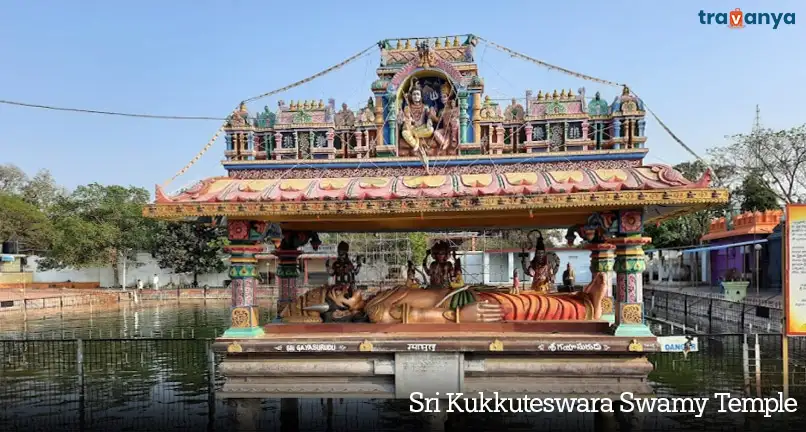
Kukkuteswara Temple is a revered Hindu temple dedicated to Lord Shiva, located in the city of Narasapuram, Andhra Pradesh, India. This sacred site has been consecrated by the sage Agastya and is recognized as one of the Aastadasa Shakti Peethas in the country. According to Hindu mythology, it is believed that part of the back of Goddess Sati fell at this location.
The Kukkuteswara Temple in Pithapuram is not only significant for its connection to Lord Shiva but also honors his consort, Parvati. The presiding deity, Kukkuteswara Swamy, represents a unique aspect of Shiva. With its rich historical significance & renowned divine power, the temple attracts numerous pilgrims throughout the year, making it a vibrant center of worship & devotion.
- Location: Uppada – Pithapuram Rd, Kalyanamandapm, Pithapuram, Andhra Pradesh 533450
- Country: India
- Nearest Airport: Visakhapatnam International Airport (RJA)
- Deity: Kukkuteswara (Shiva); Rajarajeswari Devi; Puruhutika Devi
- Temple Timings: 6:30 AM to 12:30 PM, 4:30 PM to 8:30 PM
- Festivals: Maha Sivaratri, Navaratri, Karthika Masam
- Best Time To Visit In: September to February
10. Biraja Temple – Oddyana Peetham
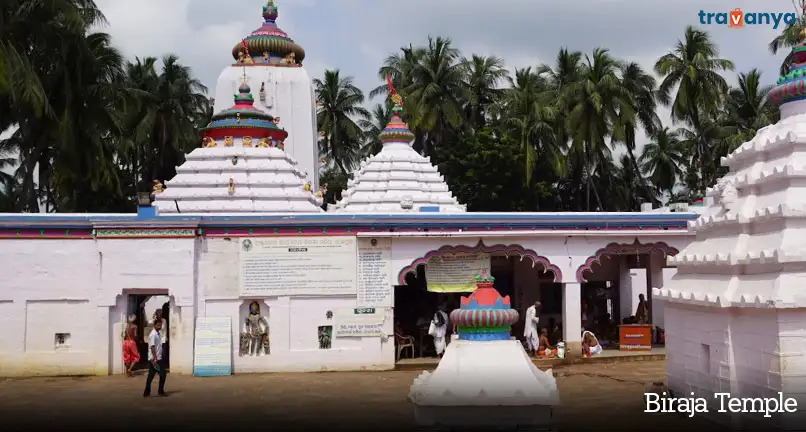
Birla Mandir, also known as Viraj Kshetra or Birja Peeth, is a historic Hindu temple situated in the heart of Jajpur, Odisha. This revered temple is dedicated to Goddess Durga & is famous for its annual fair, drawing lakhs of pilgrims from across India.
Borja Kshetra holds a special place among Hindus, recognized as one of the 51 Shakti Peethas dedicated to the worship of the divine Goddess Shakti. According to the Tantra Chudamani, the navel of Goddess Sati, who was the consort of Lord Shiva, is believed to have fallen in this location after her self-immolation. This sacred connection enhances the temple’s significance, making it a major pilgrimage destination for devotees seeking blessings & spiritual fulfillment.
- Location: R8MQ+F77, Jajpur, Odisha 755007
- Country: India
- Nearest Airport: Biju Patnaik International Airport
- Built-In: 13th Century
- Deity: Devi Durga as Viraja
- Temple Timings: 6:00 AM to 5:00 PM
- Festivals: Nakshatra, Shravana, Prathamastami, Pana Sankranti, Raja Parva, Navanna
- Best Time To Visit In: October or February
11. Draksharama Bheemeswara Swamy Temple – Daksharama Peetham
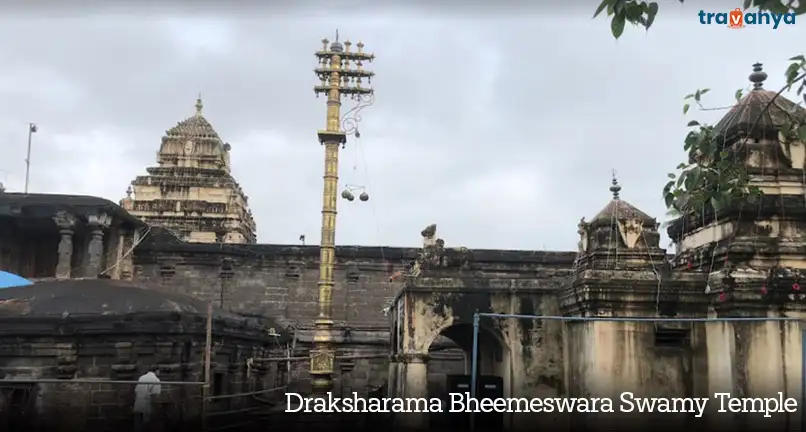
Draksharamam Temple, situated in the East Godavari district of Andhra Pradesh, India, is one of the five principal temples dedicated to Lord Shiva & one of the eighteen esteemed Maha Shakti Peethas in the country. According to local belief, the left cheek of Goddess Sati is said to have fallen at this site, making the Bhimeshwar Temple highly significant for Hindus.
Draksharam is often referred to as Dakshina Kashi, or the Varanasi of the South, due to its rich legends & spiritual heritage. It is believed that the Daksha Yagna occurred here, where Lord Shiva sanctified the area following a devastating incident involving Lord Veerabhadra. Today, the Bhimeshwar Temple stands as one of the holiest destinations for devotees of Lord Shiva in India, attracting numerous pilgrims seeking blessings & spiritual solace.
- Location: 3-152 ANDHRA BANK STREET, Chandra St, Draksharamam, Andhra Pradesh 533262
- Country: India
- Nearest Airport: Vijayawada International Airport (VGA)
- Built-In: 9th and 10th Centuries CE
- Built-By: Eastern Chalukya King
- Deity: Maa Manikyamba
- Architectural Styles: Dravidian Architecture
- Temple Timings: 5:30 AM to 12:00 PM, 4:00 PM to 8:30 PM
- Festivals: Maha Shivaratri, Kartik Purnima
- Best Time To Visit In: October to November
12. Alopi Devi Mandir – Prayaga Peetham
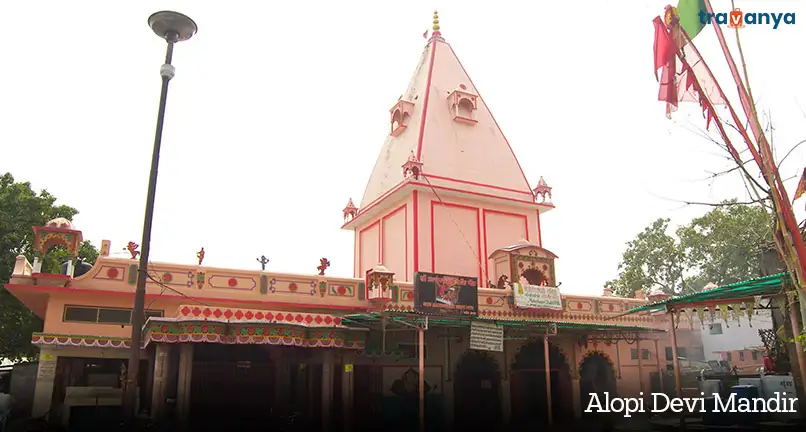
Alopi Devi Temple, located in Prayag Raj (formerly Allahabad), Uttar Pradesh, is a revered Hindu temple dedicated to Goddess Alopi, an incarnation of Parvati, who is the consort of Lord Shiva. This temple is recognized as one of the prominent Aastadasa Shakti Peethas in India & serves as an important pilgrimage destination for Hindus.
According to legend, ten fingers of Goddess Sati are believed to have fallen at this site, contributing to the temple’s spiritual significance. Thousands of devotees from the region worship Alopi Devi, celebrating various life events such as festivals, marriages, births, & even mourning rituals with their beloved deity. The temple stands as a testament to the enduring faith & devotion of its followers, reflecting its importance in Hindu spirituality over the years.
- Location: Alopi Bagh, Prayagraj, Uttar Pradesh 211006
- Country: India
- Nearest Airport: Lal Bahadur Shastri International Airport (VNS)
- Built-In: 1772 AD
- Built-By: Shreenath Mahadji Shinde
- Deity: Maa Madhaveswari
- Architectural Styles: Nagara Style
- Temple Timings: 7:30 AM to 7:30 PM
- Festivals: Navratri, Diwali
- Best Time To Visit In: October or March
13. Jwalamukhi Temple – Jwalamukhi Peetham
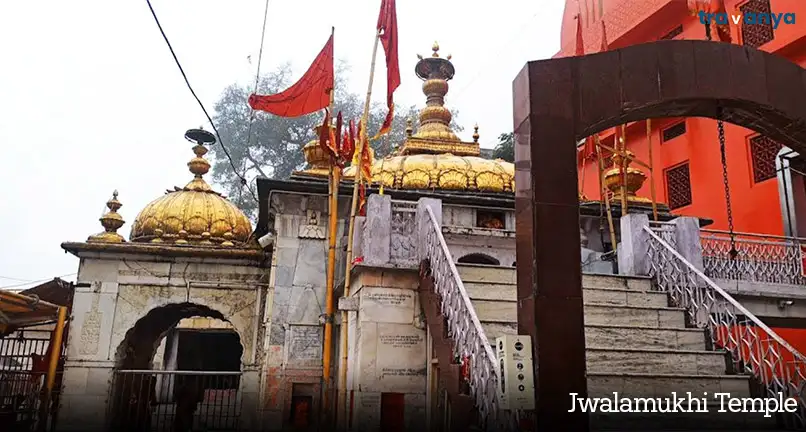
Jwalamukhi Temple is a renowned Hindu temple dedicated to Goddess Jwalamukhi, situated in the town of Jwalamukhi in the Kangra district of Himachal Pradesh, India. This temple is a significant pilgrimage site for followers of Shaktism, a branch of Hinduism, & is famous for its eternal flame, which is said to burn without any fuel.
According to legend, when Goddess Sati’s body was divided into 51 pieces, her tongue fell in the Jwalamukhi region. This event marks the temple as a crucial site for worship in Shaktism. The eternal flame within the temple is believed to have been burning since ancient times, adding to the spiritual atmosphere of the location.
To fully experience the enchantment of this sacred place, consider booking a Himachal Tour Package and ask your travel agent to include this significant Shakti Peetha in your itinerary.
Important Note: It is worth mentioning that there are four Jwalamukhi temples located at Jwalaji, Jwalaji Kangra in Kashmir, Jwala Devi of Shaktinagar, & Jwala Mai of Muktinath. Each of these temples is dedicated to a different aspect of Maa Durga, representing the divine feminine.
- Location: Jawala Ji Temple Rd, Kohala, Jawalamukhi, Himachal Pradesh 176031
- Country: India
- Nearest Airport: Kangra-Gaggal Airport (DHM)
- Built-By: Raja Bhumi Chand Katoch
- Deity: Maa Jwalamukhi
- Architectural Styles: Indo-Sikh Architecture
- Temple Timings: 24 Hours
- Festivals: Navratri, Diwali, Durga Pooja
- Best Time To Visit In: September to October
14. Mangla Gauri Temple – Gaya Peetham
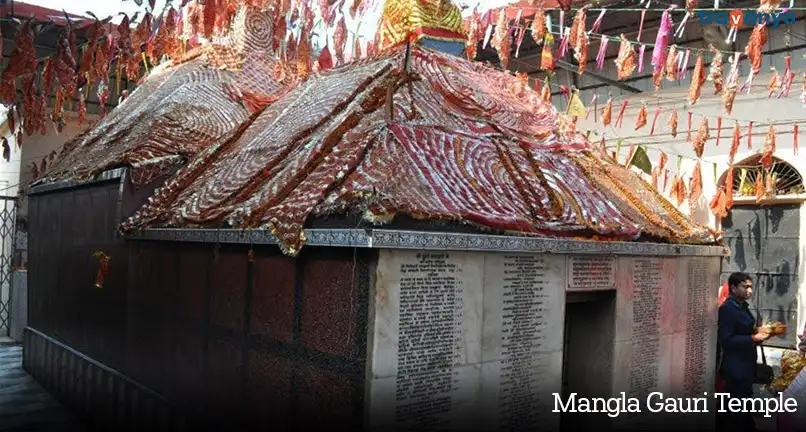
Maa Mangla Gauri Temple is a renowned Hindu shrine located in Gaya, Bihar, India. This temple is dedicated to Goddess Mangala Gauri, an incarnation of Parvati, who is known as the consort of Lord Shiva. The temple is celebrated for its exquisite carvings, beautiful sculptures, & distinctive roof design, making it a significant attraction in Gaya.
According to Hindu legends, this site is where a part of Goddess Sati’s breast is believed to have fallen. The sanctum sanctorum features a beautifully crafted idol of the Goddess, surrounded by intricately designed sculptures. Additionally, there are smaller shrines dedicated to Lord Shiva, Goddess Durga, & Dakshina Kali. Devotees from various places visit this temple to receive the Goddess’s blessings.
- Location: Mangla Gauri Mandir Rd, Shakti Peetham, Gaya, Bihar 823001
- Country: India
- Nearest Airport: Gaya Airport (GAY)
- Built-In: 1300 CE
- Built-By: Maadho Giri Ji Maharaj (Baba Dandi Swami)
- Deity: Sati (Goddess Parvati)
- Architectural Styles: Indian Rock-cut Architecture
- Temple Timings: 6:00 AM to 8:00 PM
- Festivals: Navratri
- Best Time To Visit: April to October
15. Vishalakshi Temple – Varanasi Peetham
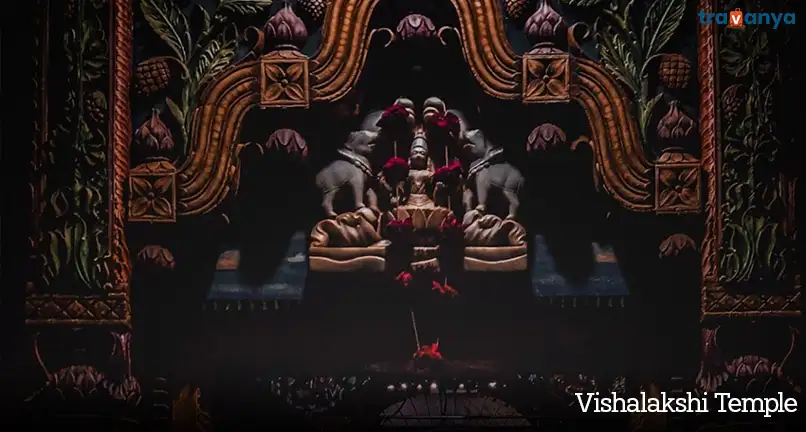
Vishalakshi Temple is a revered Shakti Peeth, one of India’s most significant temples. Dedicated to Goddess Parvati, known as Vishalakshi, which means “she with big eyes,” the temple is situated in Varanasi along the banks of the Ganges River. The main idol of Parvati is prominently displayed, flanked by representations of her husband, Lord Shiva, & their son, Ganesha.
As one of the Aastadasa Shakti Peeths, this temple holds a special place in Hinduism, believed to be where the wrist of Sati, an incarnation of the Goddess Shakti, is said to have fallen to the earth. Today, Vishalakshi Temple is a major tourist destination, attracting hundreds of thousands of visitors each year who come to pay their respects and seek blessings.
- Location: Shri Kashi Vishalakshi Mata Shaktipeeth Temple, Kashi Lahori Tola Near Ganpati Guest House Meer Ghat, Varanasi, Uttar Pradesh 221001
- Country: India
- Nearest Airport: Lal Bahadur Shastri International Airport
- Built-In: 1893AD
- Built-By: Nagarathar
- Deity: Vishalakshi
- Architectural Styles: Tamil Architecture
- Temple Timings: 6:00 AM to 10:00 PM
- Festivals: Navaratri
- Best Time To Visit: March or April to September or October
Note: As per the Skanda Purana, there are 18 Mahashakti Peethas, with 16 of them situated in India, while the remaining two are found in Pakistan and Sri Lanka. Notably, the Kamakhya Temple in Assam is also included among these revered 18 Mahashakti Peethas.
| Temple | Place | Country | Shakti Peeth | Part of the body fallen | Deity |
| Shankari Temple (part of the Koneswaram Temple) | Trincomalee | Sri Lanka | Lankayam Shankari Peetham | Groin | Shankari |
| Sharada Peeth | Sharda, Kashmir | Pakistan Administered Kashmir | Sharada Peetham | Right hand | Maa Sharada Devi |
List of Other Shakti Peethas
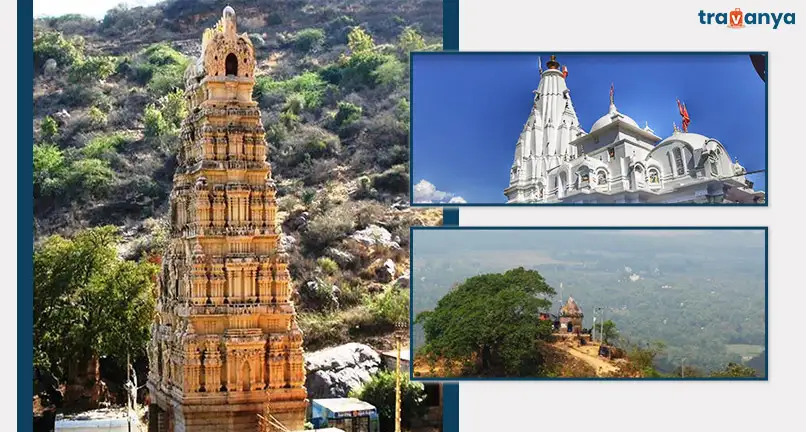
Across India & its neighboring countries, many Shakti Peeth temples are found, each associated with a different body part of Goddess Shakti. While the origins of these holy sites are somewhat obscure, they have been revered by countless pilgrims for centuries.
The significance of these temples is detailed in the Tantrachūḍamanī, where Goddess Parvati explains their importance to her son, Skanda.
| Temple Name | State in India/Country | Body part or Ornament | Deity/Shakti |
| Amarnath Temple | Jammu and Kashmir | Throat | Mahamaya |
| Shri Parvat | Ladakh | Right Anklet | Mahamaya |
| Attahas Temple | Purba Bardhaman, West Bengal | Lips | Phullara (Sati) |
| Bahula | Ketugram Village, West Bengal | Left arm | Goddess Bahula |
| Bakreshwar | District Birbhum, West Bengal | Portion between the Eyebrows | Mahishmardini |
| Bhairavparvat | Ujjain, Madhya Pradesh | Elbow | Avanti |
| Bhabanipur | Bangladesh | Left anklet (ornament) | Aparna |
| Chhinnamastika Shaktipeeth | Chintpurni, Himachal Pradesh | Foot | Chhinnamastika |
| Muktinath Temple | Nepal | Right cheek | Gandaki Chandi |
| Goddess Bhadrakali – Shree Saptashrungi Gad Devi Temple | Saptashurngi, Maharashtra | Chin (2 parts) | Bhadrakali |
| Hinglaj Mata Temple | Pakistan | Bramharandhra (Part of the head) | Kottari |
| Jayanti Shaktipeeth Shri Nartiang Durga Temple | Nartiang, Meghalaya | Left thigh | Jayanti |
| Jeshoreshwari Kali Temple | Bangladesh | Palms of hands and soles of the feet | Jashoreshwari |
| Jwalaji | Jawalamukhi, Himachal Pradesh | Tongue | Siddhida (Ambika) |
| Kankalitala (Kankaleshwari) | Bolpur, West Bengal | Pelvis | Devgarbha |
| Kanyashram of Balaambika and Gourikunda Temple | Tamil Nadu or Yunnan, China or Sitakunda, Chattogram, Bangladesh | Back | Sarvani |
| Bajreshwari Temple | Kangra, Himachal Pradesh | Left Breast | Jayadurga |
| Kiriteswari Temple | Murshidabad, West Bengal | Crown | Vimla |
| Ratnavali – Anandamayee Tala | Khanakul, West Bengal | Right Shoulder | Kumari |
| Bhramari Devi | Fulbari, West Bengal | Left leg | Bhraamari |
| Bhramari Shaktipeeth Maa Malai Chandi Temple | Amta, West Bengal | Part of Left Knee | Bhraamari |
| Manasa Peetha | China | Right hand | Dakshayani |
| Shri Raj Rajeshwari Puruhuta Manivedic Shaktipeeth (Chamunda Mandir) | Pushkar Rural, Rajasthan | Wrists | Gayatri |
| Mithila temple | Nepal | Left shoulder | Uma |
| Nainativu Nagapooshani Amman Temple | Sri Lanka | Silambu (Anklets) | Indrakshi (Nagapooshani / Bhuvaneswari) |
| Guhyeshwari Temple | Nepal | Both knees | Mahashira |
| Chandranath Temple | Bangladesh | Right arm | Bhavani |
| Varahi Devi Temple (Panchsagar Shaktipeeth) | Uttarakhand | Lower teeth/ Navel | Varahi |
| Shree Chandrabhaga Shaktipeeth | Prabhas-Patan, Gujarat | Stomach | Chandrabhaga |
| Shri Sthaneshwar Mahadev Temple, Thanesar | Thanesar, Haryana | Ankle bone | Savitri/BhadraKali |
| Maa Sharda Temple | Maihar, Madhya Pradesh | Necklace | Shivani |
| Nandikeshwari Temple | Sainthia, West Bengal | Necklace | Nandini |
| Sri Umakotilingeswara Swamy Sri Sitarama Swamy Temple (Kotilingeswar Ghat Temple) | Rajahmundry, Andhra Pradesh | Cheeks | Bhuvaneswari or Vishweshwari |
| Naina Devi Temple | Bilaspur, Himachal Pradesh | Right eye | Mahishmardini |
| Shondesh Shakti Peeth | Amarkantak, Madhya Pradesh | Right Buttock | Narmada |
| Sri Bhramaramba Shakti Peeth Temple | Srisailam, Andhra Pradesh | Neck | Bramarambika |
| Narayani Shakti Peeth ( Suchindram Shaktipeeth) | Suchindram, Tamil Nadu | Teeth Part | Narayani |
| Shaktipeeth Shri Sunanda Devi Mandir | Bangladesh | Nose | Sugandha |
| Tripura Sundari Temple | Matabari, Udaipur | Right Leg | Tripura Sundari |
| Ujani Shaktipeeth Shri Mangal Chandi Temple | Nutanhat, West Bengal | Right Wrist | Mangal Chandika |
| Manikarnika Ghat | Lahori Tola, Varanasi, Uttar Pradesh | Face or Earring | Vishalakshi & Manikarni |
| Kapalini (Bhimarupa) Shaktipeeth Maa Bargabhima Temple | Tamluk, West Bengal | Left ankle | Kapalini (Bhimarupa) also known as Bargabhima |
| Shri Ambika Shaktipeeth | Papri, Rajasthan | Fingers of Left Leg | Ambika |
| Shri Shri Katyayani Peeth | Vrindavan, Uttar Pradesh | Ringlets of Hair | Uma |
| Devi Talab Mandir | Jalhandar, Punjab | Left Breast | Tripurmalini |
| Baba Baidyanath Temple | Deoghar, Jharkhand | Heart | Jaya Durga |
| Shri Jogadya Shaktipeeth | Kshirgram, West Bengal | Great Toe | Jogadya |
| Shri Puruhutika Shaktipeeth | Pithapuram, Andhra Pradesh | Hip Part | Purohotika |
| Shri Arasuri Ambaji Mata Devasthan | Khodiyar Chowk, Ambaji, Gujarat | Heart | Amba |
| Jwaladevi Temple | Shaktinagar, Sonbhadra, Uttar Pradesh | Tongue | Jwala Devi |
| Chandika Sthan | Munger Town, Bihar | Left Eye | Chandika Devi |
| Danteshwari Temple | Dantewada, Chhattisgarh | Tooth or Daant | Danteshwari devi |
| Juranpur Satipith | Nadia, West Bengal | Forehead | Jaya Durga |
| Nalhateswari | Nalhati, West Bengal | Stomach/Nauli | Kalika |
| Kamakhya Temple Mankachar | Thakurarbari, Meghalaya | Little Finger | Devi |
| Anjanakshi (Marundeeswarar Temple) | Thirukkachur, Kattankulathur, Tamil Nadu | Skin | Anjanakshi |
| Jayanti Maha Shakti Peeth | Jayanti, Alipurduar, West bengal | Left Shank | Jayanti |
| Shri Hatta Kali Temple or Shri Shail (also known as Mahalakshmi Griva Peeth) | Gotatikar, Kalagul tea state, Dakshin Surma Upazila, Sylhet, Bangladesh | Neck | Mahalakshmi |
| Dhakeswari Mata Temple | Dhaka, Bangladesh | Gem of Sati’s Crown | Dhakeshwari (a form of Katyani Mahishasurmardini Durga) |
| Tarapith Temple | Tarapith, Rampurhat, West Bengal | Third eye | Maa Tara (second mahavidya) (main form of Parvati) |
| Lalta Maata Mandir Neemsaar | Sitapur, Uttar Pradesh | Heart | Maa lalta devi mandir (goddess heart) (main heart form of Parvati) |
Frequently Asked Questions
Q: What is a Shakti Peeth?
A: Shakti Peeths are sacred pilgrimage sites in Hinduism and Sikhism, spread across the Indian subcontinent. They are dedicated to Goddess Shakti, who is worshipped as Lord Shiva’s consort. These temples are linked to the story of Goddess Sati, whose body was cut into pieces by Lord Vishnu. The places where these pieces fell on Earth became known as Shakti Peeths. Each Shakti Peeth is believed to hold strong spiritual energy and is a holy destination for many Hindus.
Q: Is Vaishno Devi a Shakti Peeth?
A: Yes, the Vaishno Devi Temple, located in Trikuta Parvat, Jammu and Kashmir, is a Hindu shrine dedicated to Vaishno Devi, an incarnation of Goddess Durga. It is one of the most visited temples in India and is also recognized as one of the 108 Shakti Peeths, which are sacred to Goddess Durga.
Q: Which Shakti Peeth is in China?
A: There is a Shakti Peeth in China called Mansa Shakti Peeth. It is located near the Chinese-controlled Lake Mansarovar. According to mythology, this is where the right hand of Goddess Sati fell, making it a powerful and sacred site of worship for Goddess Shakti.
Q: How many Shakti Peethas are there in Karnataka?
A: Karnataka is home to 9 Shakti Peeth temples. These are:
- Savadatti Yallamma
- Badami Sri Banashankari
- Shirazi Marikamba
- Horanadu Sri Annapoorneshwari
- Sringeri Sharadamba
- Shri Chamundeshwari Devi, Mysore
- Sri Katilu Durgaparameswari
- Kolluru Mookambika
- Siganduru Sri Chowdeswari Devi
Q: Are Sati and Parvati the same?
A: Yes, Sati and Parvati are considered to be the same goddess in Hindu mythology. Both are forms of the divine feminine energy and are known as the wives of Lord Shiva. While Sati is known for her sacrifice, Parvati is revered as the mother goddess and creator.ure and history. Each temple has its own story, and each temple is worth visiting if you are interested in Indian culture. If you are planning a trip to India, make sure to include some of these temples in your itinerary.
The Shakti Peeth temples are a series of temples in India dedicated to the Goddess Shakti. Shakti is the female manifestation of the god Shiva & is said to be present in different temples throughout India. However, the precise number of temples is not yet definitively known; it may be less or more. Some people believe there are around 108 Shakti Peethas, but this is still being debated. The information in this blog is verified by reliable sources. Hopefully, this provides you with a better understanding of the topic.
Plan your next adventure with Travanya, a highly-rated travel agency in Panchkula (Tricity). Whether you’re looking to explore India or travel internationally, we specialize in helping travelers secure the finest holiday packages for unforgettable experiences.
Our team of travel specialists is here to assist you with everything from flight bookings and route planning to schedules and accommodations. Thanks to our strong partnerships with leading airlines, we can also secure the best flight deals for you. For more information about our services, call us at +91-869-999-5345
About Navneet View All Posts
Navneet Kaur is a Professional Content Writer with 5+ years of experience, she started her career as a Content Writer. Apart from having good knowledge of marketing and business, she firmly believes in dreaming big and making them come true. She lives with a passion to explore and learn about adventure, destinations, history and live events happening around. Including her travel writing skills, she has also written about places, arts and entertainment, personal experiences, nature and its beauty, etc.



Leave a Comment